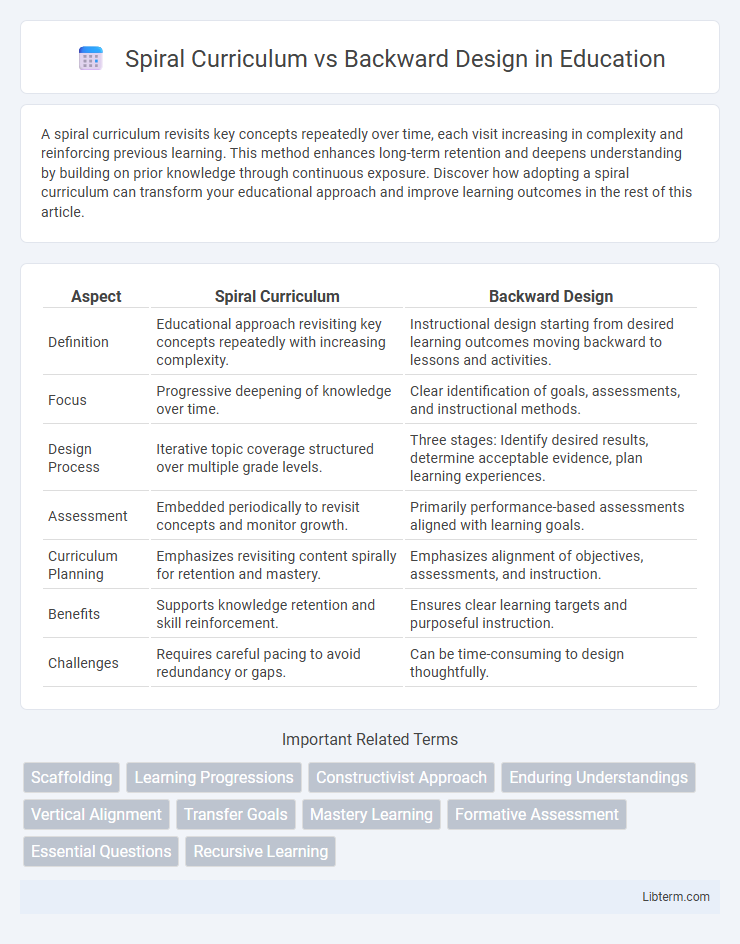A spiral curriculum revisits key concepts repeatedly over time, each visit increasing in complexity and reinforcing previous learning. This method enhances long-term retention and deepens understanding by building on prior knowledge through continuous exposure. Discover how adopting a spiral curriculum can transform your educational approach and improve learning outcomes in the rest of this article.
Table of Comparison
| Aspect | Spiral Curriculum | Backward Design |
|---|---|---|
| Definition | Educational approach revisiting key concepts repeatedly with increasing complexity. | Instructional design starting from desired learning outcomes moving backward to lessons and activities. |
| Focus | Progressive deepening of knowledge over time. | Clear identification of goals, assessments, and instructional methods. |
| Design Process | Iterative topic coverage structured over multiple grade levels. | Three stages: Identify desired results, determine acceptable evidence, plan learning experiences. |
| Assessment | Embedded periodically to revisit concepts and monitor growth. | Primarily performance-based assessments aligned with learning goals. |
| Curriculum Planning | Emphasizes revisiting content spirally for retention and mastery. | Emphasizes alignment of objectives, assessments, and instruction. |
| Benefits | Supports knowledge retention and skill reinforcement. | Ensures clear learning targets and purposeful instruction. |
| Challenges | Requires careful pacing to avoid redundancy or gaps. | Can be time-consuming to design thoughtfully. |
Introduction to Spiral Curriculum and Backward Design
Spiral Curriculum is an educational approach where key concepts are revisited repeatedly over time with increasing complexity, reinforcing deeper understanding and long-term retention. Backward Design begins with setting clear learning goals and desired outcomes before planning instructional activities, ensuring alignment between objectives, assessments, and teaching methods. Both methods prioritize structured learning but differ in their approach to sequencing content and assessment planning.
Core Principles of Spiral Curriculum
The Spiral Curriculum emphasizes revisiting key concepts repeatedly over time, each iteration increasing in complexity to deepen understanding and retention. This method aligns with cognitive development theories, promoting mastery through spaced reinforcement and scaffolded learning experiences. Central to this approach is the systematic layering of knowledge, allowing students to build on prior learning and connect new information within a progressively expanding framework.
Foundational Concepts of Backward Design
Backward Design centers on identifying desired learning outcomes before planning instruction, emphasizing foundational concepts that guide curriculum development. This approach ensures that assessment and teaching strategies are aligned with core learning goals, fostering deeper understanding and long-term retention. By contrast, Spiral Curriculum revisits topics cyclically, but Backward Design's focus on explicit learning targets drives more targeted and efficient educational planning.
Key Differences Between Spiral Curriculum and Backward Design
Spiral Curriculum revisits core concepts at increasing levels of complexity, enabling cumulative learning and reinforcement, while Backward Design starts with setting learning goals and planning assessments before instructional activities, emphasizing desired outcomes. Spiral Curriculum promotes iterative skill development through gradual content expansion, whereas Backward Design ensures curriculum alignment by defining clear objectives first. The key difference lies in Spiral Curriculum's cyclical content revisiting versus Backward Design's outcome-driven, goal-first planning approach.
Advantages of Implementing Spiral Curriculum
Implementing a Spiral Curriculum enhances long-term retention by revisiting key concepts at increasing levels of complexity, reinforcing learning through repeated exposure. This approach promotes deeper cognitive connections and allows for continuous skill development, adapting to students' evolving understanding. Spiral Curriculum also supports differentiated instruction by accommodating varied learning paces without sacrificing content comprehensiveness.
Benefits of Using Backward Design in Education
Backward Design enhances curriculum effectiveness by starting with clear learning goals, ensuring all activities and assessments are aligned with desired outcomes. This approach promotes deeper understanding and mastery by prioritizing essential skills and knowledge, leading to more targeted and purposeful instruction. Teachers can better measure student progress and adapt teaching strategies to meet specific objectives, resulting in improved educational achievement.
Challenges and Limitations of Each Approach
The Spiral Curriculum faces challenges in ensuring sufficient mastery of foundational concepts before revisiting topics, which may lead to gaps in understanding or repetitive learning for some students. Backward Design often encounters limitations in flexibility, as its rigid focus on predetermined learning outcomes can constrain teacher creativity and adaptability to student needs. Both approaches require careful balance between pacing, content depth, and assessment alignment to maximize educational effectiveness.
Impact on Student Learning Outcomes
Spiral Curriculum reinforces student learning outcomes by revisiting key concepts at increasing levels of complexity, thereby deepening understanding and promoting long-term retention. Backward Design focuses on clearly defined learning goals and assessment criteria, ensuring instructional activities align directly with desired outcomes to enhance mastery. Studies indicate that Spiral Curriculum improves conceptual continuity, while Backward Design increases goal-oriented learning efficiency and measurable achievement.
Integrating Spiral Curriculum and Backward Design
Integrating Spiral Curriculum and Backward Design enhances learning by combining the iterative reinforcement of key concepts with goal-oriented planning that begins with desired outcomes. This approach ensures that essential skills are revisited with increasing complexity while assessments and instructional activities align precisely with learning objectives. Educators benefit from a cohesive framework that promotes mastery through targeted, well-structured progression and measurable performance benchmarks.
Choosing the Right Curriculum Design for Your Context
Selecting the appropriate curriculum design depends on the educational goals and learner needs; Spiral Curriculum revisits core concepts gradually building complexity, ideal for subjects requiring reinforcement and cumulative learning such as mathematics and science. Backward Design starts with clearly defined outcomes and assessment criteria, guiding curriculum development to ensure alignment between objectives, instruction, and evaluation, making it effective for goal-oriented or standards-based education. Analyzing student readiness, content complexity, and assessment priorities helps educators decide whether the iterative revisiting of topics in Spiral Curriculum or the outcome-focused planning of Backward Design best supports their instructional context.
Spiral Curriculum Infographic

 libterm.com
libterm.com